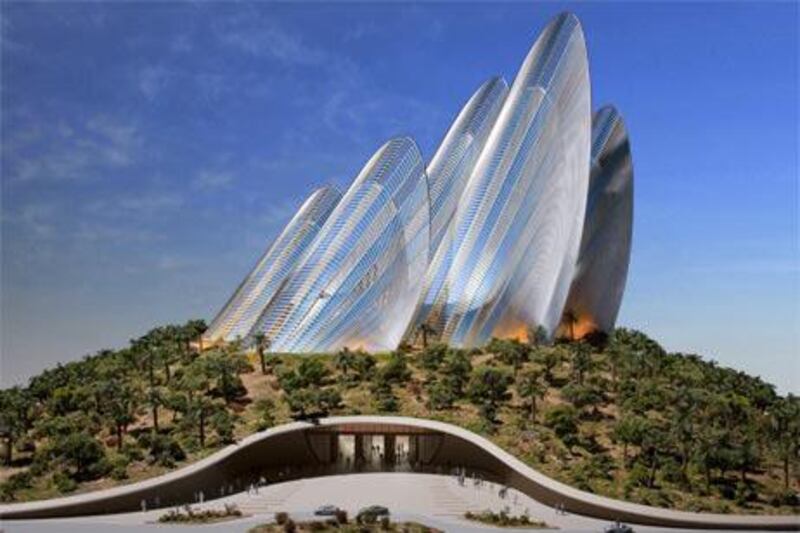ABU DHABI // Education, conservation, environmental protection, preserving heritage, and the embrace of progress: they were core values embodied by the late Sheikh Zayed in life, and will be celebrated when the Zayed National Museum opens on Saadiyat Island in 2014.
Unveiled by Queen Elizabeth II and Sheikh Mohammed bin Rashid, Vice President of the UAE and Ruler of Dubai, in a ceremony yesterday, the landmark museum and library will tell the story of the nation's founder, his struggle to unify the emirates and his success in nurturing the nation into what it is today.
"He was a school, the school we want all generations to learn from - to learn his thinking, to learn his sharing, to learn everything that was around him," said Mohammad Ahmad al Bowardi, the secretary general of the Executive Council, at the unveiling of the museum's design and programming.
Mr al Bowardi called Sheikh Zayed "one hundred men in one man" and said the 66,000-square-metre museum would be a testament to the nation's strength.
The new museum, which is being developed with the help of the British Museum, will incorporate five galleries, a library, educational facilities and a fine dining restaurant. As the cornerstone of the Saadiyat Island cultural hub, it will honour the life and achievements of Sheikh Zayed and the history of the UAE.
"The Zayed National Museum will embrace his philosophy by presenting the story of the nation in a way that all audiences will be able to develop their knowledge of the country and the region," said Sheikh Sultan bin Tahnoon Al Nahyan, the chairman of Abu Dhabi's Tourism Development and Investment Company (TDIC).
The lower gallery, entitled Sheikh Zayed: Life and Times, is the heart of the museum, and complementing it will be exhibitions featuring archaeological material, interactive displays and art.
The museum's centrepiece, the Sheikh Zayed gallery, will focus on the life of the founder of the nation while also telling the tale of the emirates' unification through film, audio, multimedia and artefacts from around the region.
Commenting on the new museum, Sheikh Khalifa bin Zayed, the President of the UAE and Ruler of Abu Dhabi, said: "The Zayed National Museum is destined to become an inspiring permanent reminder of the vision handed down to us from the father of our nation, the late Sheikh Zayed bin Sultan Al Nahyan to unite all Emiratis and build a strong and prosperous nation.
"As a fitting memorial and a national institution, the museum will serve as a symbol of our historic cultural roots and of the many achievements of our country, providing us with an incentive to continue building our country with the same will and determination," the official news agency WAM quoted him as saying.
Designed by the renowned British firm Foster and Partners, the building is meant to resemble the wingtips of falcons, a symbol of UAE heritage and culture. Five towers, made of lightweight steel and made to look like feathers, will rise out of a man-made hill that will house a public lobby. The tallest of the five wings will measure 124 metres.
In an effort to incorporate sustainable design, the structure will use natural ventilation through a system of buried ducts. Solar panels and heat exchangers are also part of the green design. The aerodynamic wings will be shaped to take advantage of prevailing breezes and the region's plentiful sunshine, which will reduce energy consumption.
The museum's galleries will be based on Sheikh Zayed's beliefs, including the importance of traditional values and heritage, the history of the region and an emphasis on humanitarianism. Falconry, a passion of Sheikh Zayed's, will be the focus of a Falconry and Conservation lower gallery dedicated to appreciating nature and wildlife.
The five upper exhibition spaces will be enclosed within "hanging pods" suspended from concrete columns. The entrance to these galleries will be from the ground floor's "cave-like" lobby.
"There is no project like this." said Lord Foster, the architect. "There is no project that I can think of which is even remotely like this. It is so totally special to this place, to its site, and to the culture that it celebrates."
A promenade and outdoor installations will be vital to the visitor experience, said Lord Foster, who noted that the museum's outdoor garden space was inspired by Sheikh Zayed's efforts to "green the desert". A bridge spanning a landscaped oasis and a narrow walkway will mark one of the entrances to the museum, while lush gardens will be created to surround the sculpted hill.
Mubarak al Muhairi, the managing director of TDIC, said the museum would appeal to tourists and residents alike but the main reason for developing it was not economic.
"The Zayed National Museum is a museum to showcase to the world the history of the UAE, the people and the tribute to the founder," Mr al Muhairi said.
The museum will be a public and civic space with dedicated educational spaces, and an auditorium and performance space aimed at sharing the legacy of Sheikh Zayed with future generations.
The idea of learning and knowledge and an emphasis on sustaining the culture of the UAE will be some of the focuses of the museum.
"Today, we have the oil. Tomorrow, we will not have the oil. We will have the minds of the people that will be an alternative for the oil [so that] the UAE will continue to contribute to the world development and peace," Mr al Bowardi said.
Construction on the museum is not expected to begin until mid-2011, with an anticipated end date in 2013. The museum is likely to open in 2014.






